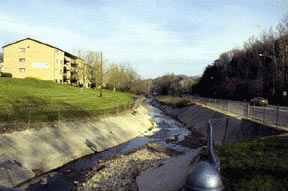CADDIS Volume 2: Sources, Stressors & Responses

Physical habitat in urban streams
Urbanization can alter the geomorphologic and vegetative structural features of stream channels—that is, their physical habitat.

Photo courtesy of USFWS
Studies have reported many physical habitat alterations associated with urbanization, including (but not limited to):
- ↑ direct channel modification (e.g., piping and burial)
[Elmore & Kaushal 2008, Roy et al. 2009] - ↑ channel enlargement
[Booth & Jackson 1997, Trimble 1997, Hession et al. 2003, Chin 2006, Allmendinger et al. 2007] - ↑ channel incision
[Booth & Jackson 1997, Hardison et al. 2009] - ↓ woody debris
[Finkenbine et al. 2000, King et al. 2005, Horwitz et al. 2008] - Δ geomorphologic units (Fig 38)
[Gregory et al. 1994, Riley et al. 2005, Shoffner & Royall 2008] - Δ streambed substrate composition (Fig 39)
[Finkenbine et al. 2000, Pizzuto et al. 2000, Walters et al. 2003, Roy et al. 2005, Blakely et al. 2006] - ↓ habitat complexity
[Riley et al. 2005, Blakely et al. 2006, Gooseff et al. 2007]
See the Physical Habitat module for more general discussion of physical habitat in streams (i.e., not just urban streams).
Click below for more information on specific topics




Figure 38. Schematic representation of the run, riffle and pool structure in two natural and two urban streams in southern California (the rectangle with an X in one of the urban streams represents a culvert). Urban streams had longer habitat segments, higher percentages of runs, and reduced habitat complexity.
From Riley SPD et al. 2005. Effects of urbanization on the distribution and abundance of amphibians and invasive species in southern California streams. Conservation Biology 19(6):1894-1907. Reprinted with permission.
From Riley SPD et al. 2005. Effects of urbanization on the distribution and abundance of amphibians and invasive species in southern California streams. Conservation Biology 19(6):1894-1907. Reprinted with permission.

Figure 39. Typical grain-size histograms from urban and rural catchments. The frequency of < 2 mm particles more than doubled in urban streams. Rural streams had a secondary sediment size mode at 8-16 mm; this secondary mode was absent in urban channels, suggesting that these substrate sizes were selectively removed from urban streams.
From Pizzuto JE et al. 2000. Comparing gravel-bed rivers in paired urban and rural catchments of southeastern Pennsylvania. Geology 28(1):79-82. Reprinted with permission.
From Pizzuto JE et al. 2000. Comparing gravel-bed rivers in paired urban and rural catchments of southeastern Pennsylvania. Geology 28(1):79-82. Reprinted with permission.
